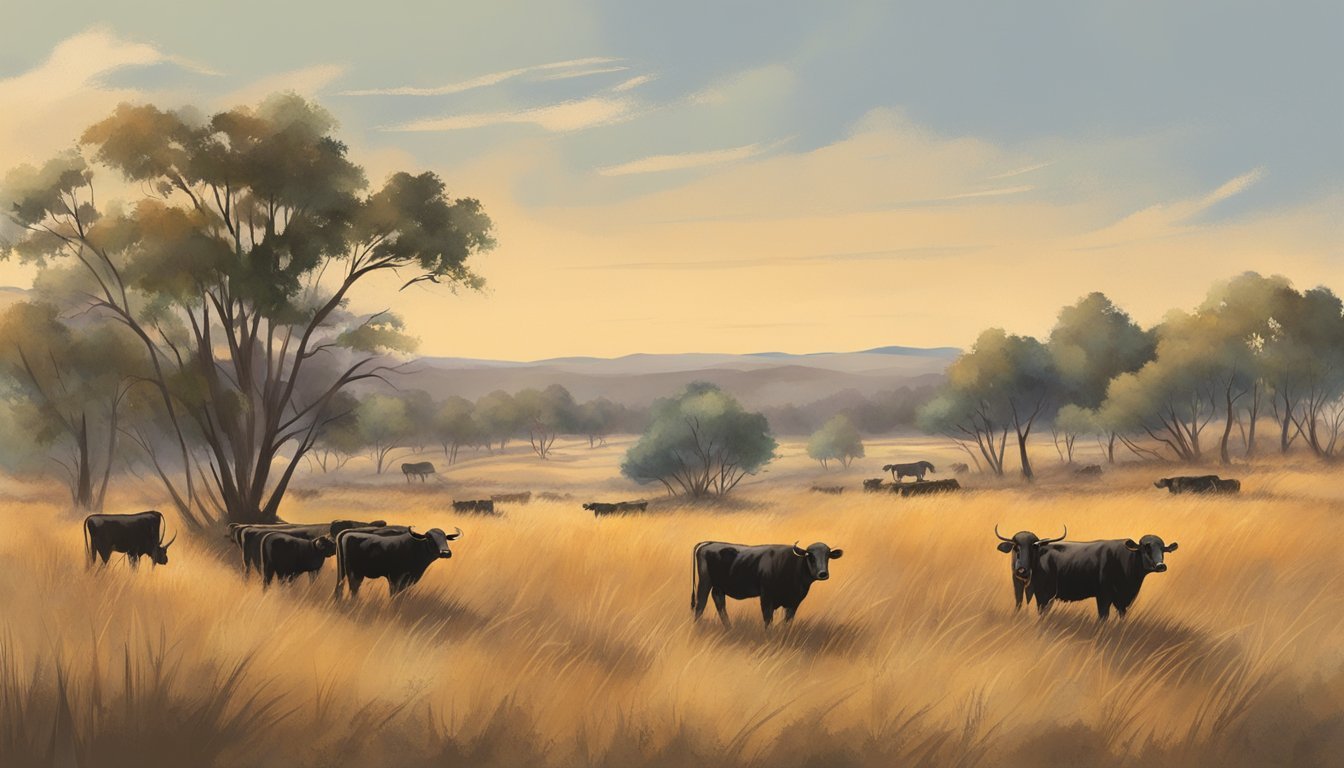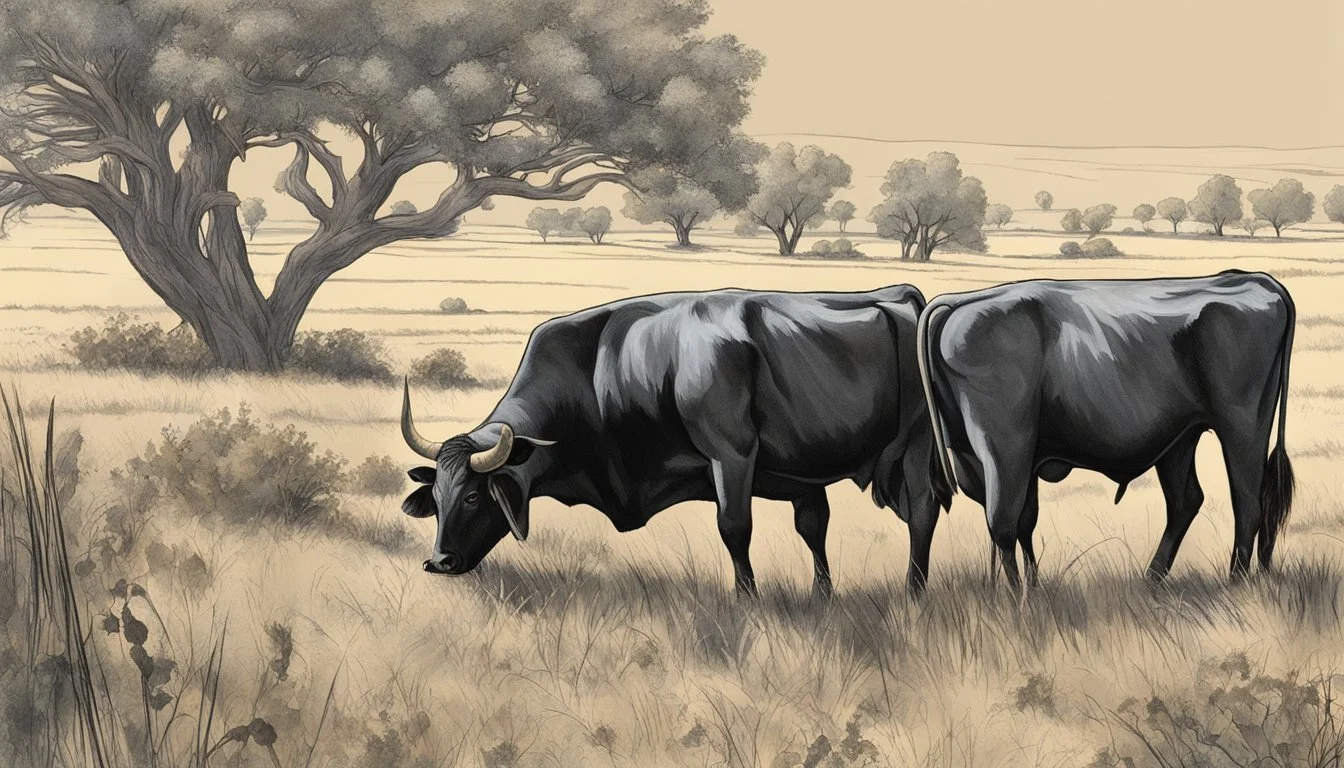Utilizing Dexter Cattle in Fire Prevention and Brush Management
An Effective Strategy
Dexter cattle, a versatile and hardy breed, have emerged as valuable partners in fire prevention and landscape management strategies. They offer a compelling solution to the accumulation of flammable brush and grasses, which can escalate the risk and intensity of wildfires. As ruminants, they naturally graze on a variety of foliage, incorporating fire risk reduction into their essential behavior by consuming plant material that would otherwise serve as fuel.
With appropriate management, these small-scale cattle can play a critical role in resource management objectives. They help maintain a balanced ecosystem by preventing the overgrowth of invasive species and promoting the growth of native plants, which benefits the overall health of the landscape. Their grazing patterns can be strategically directed to achieve desired vegetation control, turning fire prevention into a sustainable part of routine agricultural practices.
The Role of Dexter Cattle in Fire Management
Dexter cattle, a hardy and versatile breed, play a significant role in fire management through targeted grazing, reducing fuel loads, and contributing to healthier ecosystems.
Understanding Targeted Grazing
Targeted grazing involves the use of livestock to consume specific plants and reduce vegetation in designated areas. Dexter cattle, due to their size and foraging behavior, are ideal for grazing in various terrains, which makes them effective for reducing fuel loads that contribute to wildfires.
Benefits of Dexter Cattle for Brush Management
Dexter cattle are a smaller-sized beef cattle breed, which allows them to navigate rugged landscapes easily. Their moderate grazing intensity can help control brush and undesirable plants like sagebrush, cheatgrass, and weed species while preserving native plants.
Impact on Fire Regimes and Behavior
Reduced fuel loads from Dexter cattle grazing correlate with altered fire regimes and behavior. With less fuel, fires are likely to be less intense and more manageable. This is crucial in maintaining fire risk at manageable levels, especially near wildland-urban interfaces.
Contribution to Ecosystem Health
Livestock grazing by Dexter cattle contributes to the health of grasslands and rangelands. It promotes biodiversity by preventing the overgrowth of invasive species and encourages the growth of a variety of native plant species, thereby supporting various natural resources.
Fire Safety and Public Lands
On public lands, the integration of Dexter cattle for grazing can improve public safety by creating defensible spaces through fuel reduction. Their grazing helps maintain fuel continuity, which is important for protecting resources and communities from the threat of wildfires.
Case Studies: Dexter Cattle in Action
Case studies, such as those from UC Cooperative Extension and the California Cattle Council, have documented the positive effects of Dexter cattle in fire management. These studies provide practical insights into the breed's contribution to reducing fire risk across different regions.
Dexter Cattle Grazing Strategies
Effective grazing strategies involve planned herbivory with specific goals, such as fuel management. Dexter cattle stocking strategies need to be tailored considering factors like acreage, forage availability, and desired grazing intensity.
Economic and Practical Considerations
The economic aspects of employing Dexter cattle for grazing include potential fee-for-service agreements and management costs. Funding and sustainability are important factors to weigh against the benefits of fuel reduction and ecosystem services provided by these cattle.
Fire Ecology and Management Fundamentals
The effective management of wildland fires hinges on grasping the complexities of fire ecology and integrating strategic measures like grazing to sway fire behavior and achieve natural resource objectives.
Understanding Fire Ecology
Fire ecology examines the interaction between fire, vegetation, and the environment. It includes fire regimes, which characterize the frequency, intensity, and type of fires occurring in an ecosystem. Trees and shrubs play a crucial role, both as fuel for fires and as species impacted by fire events.
Modern Wildfire Trends and Concerns
A rise in catastrophic fires has been linked to factors such as climate change and fire suppression practices. More frequent wildfires and changing wildfire behavior pose increased fire hazards, particularly in the western United States, where public lands managed by agencies like the BLM are vulnerable.
Principles of Fire Prevention and Suppression
Prevention strategies like fuel breaks, firebreaks, and prescribed fire reduce fire hazard by managing vegetation. Suppression efforts involve direct intervention to control and extinguish fires to protect life, property, and resources.
Grazing as a Tool in Fire Management
Targeted livestock grazing, particularly using cows such as Dexter cattle, is recognized as a fire prevention tool. By consuming dry grasses and brush, livestock can create natural firebreaks while also meeting other natural resource objectives such as habitat improvement.
Regulations and Public Policy
Public policy and resource policy govern aspects like prescribed fire and public lands grazing. They set guidelines for when, where, and how grazing and other management tools can be used to align with ecological and societal goals, ensuring a balance between fire management and resource conservation.
Environmental and Community Impacts
Dexter cattle offer a sustainable method for fire prevention and brush management with measurable effects on ecosystems and public safety. These small-sized cattle can contribute to maintaining healthy landscapes, benefiting both the environment and local communities.
Effects on Soil and Water Conservation
Dexter cattle, through managed grazing, promote soil conservation by preventing overgrowth that can lead to soil degradation. Their activity can reduce soil compaction, allowing for better water infiltration and reduced runoff, crucial for water resources. Appropriate grazing patterns help prevent erosion, while also mitigating cheatgrass encroachment—a highly flammable and invasive species that can displace native plants and exacerbate fire risk.
Influences on Biodiversity and Wildlife
Managed grazing by Dexter cattle helps maintain varied vegetation structures, fostering a mosaic of habitats conducive to biodiversity. This practice supports diverse wildlife, including species that depend on sagebrush ecosystems. Dexter cattle can help reduce dense underbrush, thus controlling habitats for species adversely affecting the ecosystem, and aiding in the conservation of vulnerable flora and fauna.
Community Relations and the Rural Economy
Dexter cattle operations strengthen community relations by offering a communal solution to brush management that reduces fire risk. These cattle have a small footprint, which minimizes conflicts on public lands. Their integration into fire prevention strategies supports the rural economy, providing jobs and supporting local markets, while fostering cooperative approaches to land stewardship that protect homes and communities.
Fire Safety Education and Public Relations
Implementing Dexter cattle in fire management provides excellent opportunities for education and public relations initiatives. By making the link between livestock grazing and public safety clear to communities, these programs can foster better understanding and cooperation. They can empower residents with knowledge to safeguard their properties and promote fire safety as a shared community responsibility.
Operational Aspects of Grazing Programs
Effective fire prevention relies on sustainable and carefully managed grazing programs. Dexter cattle can play a pivotal role in these initiatives, with operational strategies geared towards fire threat reduction and landscape management.
Implementing Dexter Cattle Grazing Projects
To implement Dexter cattle grazing projects, precise planning is critical. Rangeland managers must determine appropriate stocking strategies that balance grazing intensity with ecological health. This often entails selecting suitable pastures, establishing the number of cattle per area, and defining the duration of grazing to optimize fuel reduction.
Monitoring and Assessing Grazing Impact
Impact assessment is an ongoing process, where the effects of cattle grazing on fuel levels are closely monitored. Quantitative measures such as biomass before and after grazing help determine the effectiveness of the grazing in fire prevention. Data collected informs adaptive management practices and ensures the sustainability of the ranch ecosystem.
Management Goals and Adaptive Strategies
For grazing programs, management goals center around mitigating fire risk while maintaining the ecological balance of the pasture. Adaptive management strategies are employed, allowing for adjustments in grazing intensity, duration, and cattle numbers based on real-time feedback and environmental conditions.
Partnerships and Stakeholder Engagement
Grazing projects thrive on collaborative efforts. Engagement with stakeholders, including rural communities, conservation groups, and public land managers, ensures a multi-faceted approach to managing public lands and private pastures. These partnerships are essential in aligning management objectives and leveraging resources for fire prevention.
Safety Protocols for Grazing in Fire-Prone Areas
Safety protocols are paramount in areas with a significant fire threat. Protocols include training for fire fighters and cattle handlers, establishing emergency plans, and equipping grazing sites with resources to protect both livestock and personnel in the event of a wildfire.
By addressing these operational aspects, Dexter cattle can be effectively utilized for fire prevention and brush management in a manner that supports the health of the ecosystem and promotes safety in fire-prone areas.
Conclusion and Future Directions
The sustainable integration of Dexter cattle in fire prevention and brush management strategies is a promising avenue, bridging traditional resource management with innovative solutions for ecological challenges. This section discusses deliberate next steps, acknowledges the balance between challenges and opportunities, identifies research imperatives, and suggests policy directions that can optimize outcomes for rangeland policy.
The Next Steps in Dexter Cattle Grazing for Fire Prevention
For fire prevention, Dexter cattle present a unique advantage due to their smaller size and lighter impact on the land. Implementing targeted grazing as a tool requires precise management goals and planning to maximize fuel removal while maintaining ecosystem health. Resource managers should:
Develop site-specific grazing plans to optimize for effective fuel reduction.
Enhance monitoring systems to track changes in fire risk and vegetation.
Challenges and Opportunities in Brush Management
Brush management, particularly against shrub encroachment, is an ongoing concern in maintaining open rangelands. While Dexter cattle exhibit proficiency in navigating and grazing dense brush, there are inherent challenges:
Balancing brush reduction with habitat conservation for wildlife.
Exploiting opportunities to employ Dexter cattle in complement with other management strategies.
Research Gaps and Emerging Topics
Continued investigation is essential to refine strategies and comprehend the long-term effects of Dexter cattle grazing on various ecosystems. Research needs include:
Longitudinal studies on the effects of grazing on plant diversity and soil health.
Exploration of emerging trends in conjunction with climate change impacts.
Policy Implications and Recommendations
Policy formulations should reflect the evolving understanding of natural resource policy, especially in terms of grazing policy. Recommendations are:
Align rangeland policy with the latest scientific findings to support adaptive management.
Incentivize innovative strategies through subsidies and grants for farmers adopting Dexter cattle grazing for brush management and fire prevention.
This approach requires a collaborative effort among policymakers, scientists, and land managers to foster a landscape resilient to fire hazards and conducive to sustainable resource management.





